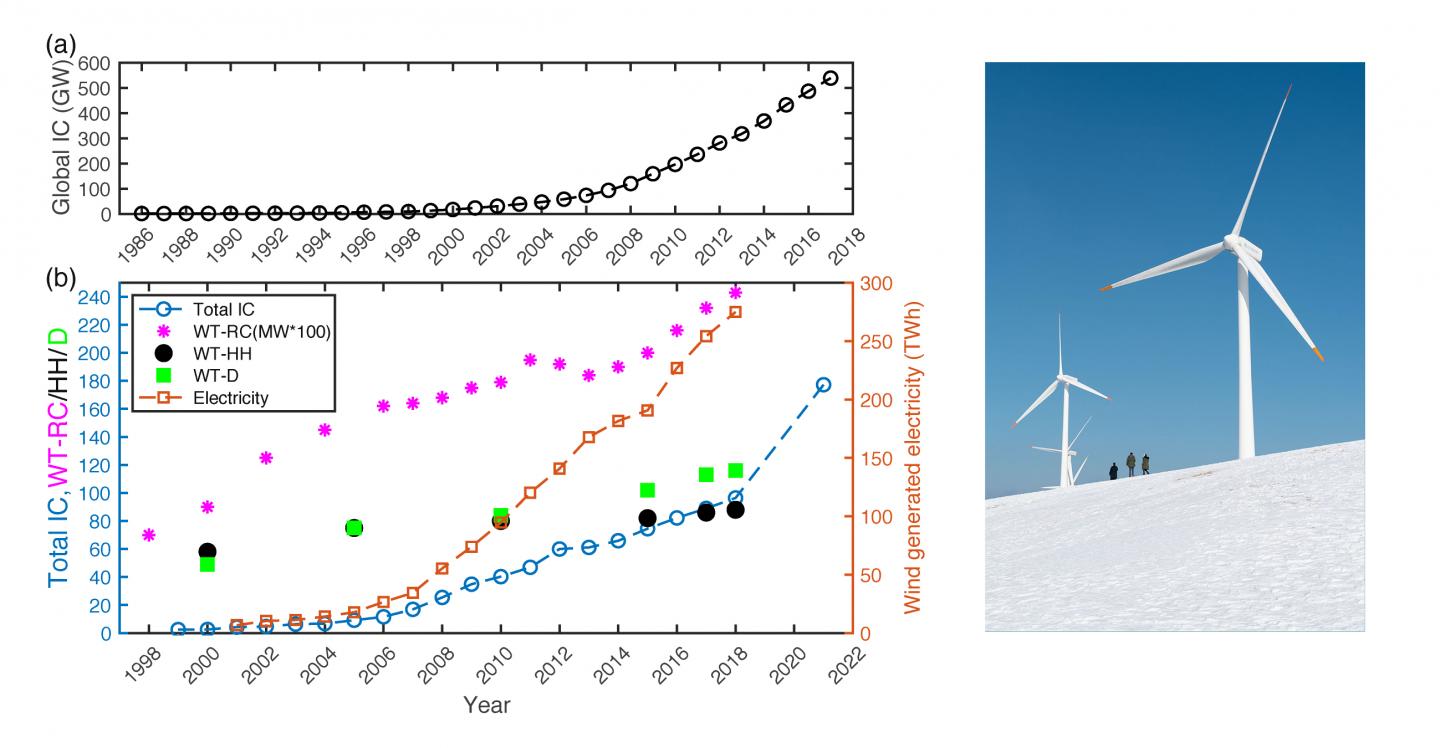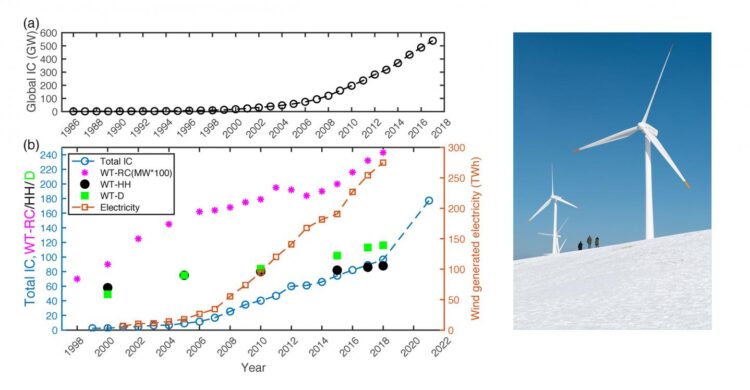TACC’s Jetstream, Wrangler and DOE NERSC Cori simulate promise

Credit: Pryor et al., CC BY 4.0
Wind power surged worldwide in 2019, but will it sustain? More than 340,000 wind turbines generated over 591 gigawatts globally. In the U.S., wind powered the equivalent of 32 million homes and sustained 500 U.S. factories. What’s more, in 2019 wind power grew by 19 percent, thanks to both booming offshore and onshore projects in the U.S. and China.
A study by Cornell University researchers used supercomputers to look into the future of how to make an even bigger jump in wind power capacity in the U.S.
“This research is the first detailed study designed to develop scenarios for how wind energy can expand from the current levels of seven percent of U.S. electricity supply to achieve the 20 percent by 2030 goal outlined by the U.S. Department of Energy National Renewable Energy Laboratory (NREL) in 2014,” said study co-author Sara C. Pryor, a professor in the Department of Earth and Atmospheric Studies, Cornell University. Pryor and co-authors published the wind power study in Nature Scientific Reports, February 2020.
The Cornell study investigated plausible scenarios for how the expansion of installed capacity of wind turbines can be achieved without use of additional land. Their results showed that the US could double or even quadruple the installed capacity with little change to system-wide efficiency. What’s more, the additional capacity would make very small impacts on local climate. This is achieved in part by deploying next generation, larger wind turbines.
The study focused on a potential pitfall of whether adding more turbines in a given area might decrease their output or even disrupt the local climate, a phenomenon caused by what’s referred to as ‘wind turbine wakes.’ Like the water wake behind a motorboat, wind turbines create a wake of slower, choppy air that eventually spreads and recovers its momentum.
“This effect has been subject to extensive modelling by the industry for many years, and it is still a highly complex dynamic to model,” Pryor said.
The researchers conducted simulations with the widely-used Weather Research Forecasting (WRF) model, developed by the National Center for Atmospheric Research. They applied the model over the eastern part of the U.S., where half of the current national wind energy capacity is located.
“We then found the locations of all 18,200 wind turbines operating within the eastern U.S. along with their turbine type,” Pryor said. She added that those locations are from 2014 data, when the NREL study was published.
“For each wind turbine in this region, we determined their physical dimensions (height), power, and thrust curves so that for each 10-minute simulation period we can use a wind farm parameterization within WRF to compute how much power each turbine would generate and how extensive their wake would be,” she said. Power and wake are both a function of the wind speed that strikes the turbines and what the local near-surface climate impact would be. They conducted the simulations at a grid resolution of 4 km by 4 km in order to provide detailed local information.
The authors chose two sets of simulation years because wind resources vary from year to year as a result of natural climate variability. “Our simulations are conducted for a year with relatively high wind speeds (2008) and one with lower wind speeds (2015/16),” Pryor said, because of the interannual variability in climate from the El Nino-Southern Oscillation. “We performed simulations for a base case in both years without the presence/action of wind turbines so we can use this as a reference against which they describe the impact from wind turbines on local climates,” Pryor said.
The simulations were then repeated for a wind turbine fleet as of 2014, then for doubled installed capacity and quadrupled installed capacity, which represents the capacity necessary to achieve the 20 percent of electricity supply from wind turbines in 2030.
“Using these three scenarios we can assess how much power would be generated from each situation and thus if the electrical power production is linearly proportional to the installed capacity or if at very high penetration levels the loss of production due to wakes starts to decrease efficiency,” Pryor said.
These simulations are massively computationally demanding. The simulation domain is over 675 by 657 grid cells in the horizontal and 41 layers in the vertical. “All our simulations were performed in the Department of Energy’s National Energy Research Scientific Computing Center (NERSC) computational resource known as Cori. Simulations presented in our paper consumed over 500,000 CPU hours on Cori and took over a calendar year to complete on the NERSC Cray. That resource is designed for massively parallel computing but not for analysis of the resulting simulation output,” Pryor said.
“Thus, all of our analyses were performed on the XSEDE Jetstream resource using parallel processing and big data analytics in MATLAB,” Pryor added. The Extreme Science and Engineering Discovery Environment (XSEDE), awards supercomputer resources and expertise to researchers and is funded by the National Science Foundation (NSF).
The NSF-funded Jetstream cloud environment is supported by Indiana University, the University of Arizona, and the Texas Advanced Computing Center (TACC). Jetstream is a configurable large-scale computing resource that leverages both on-demand and persistent virtual machine technology to support a much wider array of software environments and services than current NSF resources can accommodate.
“Our work is unprecedented in the level of detail in the wind turbine descriptions, the use of self-consistent projections for increased installed capacity, study domain size, and the duration of the simulations,” Pryor said. However, she acknowledged uncertainty is the best way to parameterize the action of the wind turbines on the atmosphere and specifically the downstream recovery of wakes.
The team is currently working on how to design, test, develop, and improve wind farm parameterizations for use in WRF. The Cornell team recently had a publication on this matter in the Journal of Applied Meteorology and Climatology where all the analysis was performed on XSEDE resources (this time on Wrangler, a TACC system) and have requested additional XSEDE resources to further advance that research.
Wind energy could play a bigger role in reducing carbon dioxide emissions from energy production, according to the study authors. Wind turbines repay their lifetime carbon emissions associated with their deployment and fabrication in three to seven months of operation. This amounts to nearly 30 years of virtually carbon-free electricity generation.
“Our work is designed to inform the expansion of this industry and ensure it’s done in a way that maximizes the energy output from wind and thus continues the trend towards lower cost of energy from wind. This will benefit commercial and domestic electricity users by ensuring continued low electricity prices while helping to reduce global climate change by shifting toward a low-carbon energy supply,” Pryor said.
Said Pryor: “Energy systems are complex, and the atmospheric drivers of wind energy resources vary across time scales from seconds to decades. To fully understand where best to place wind turbines, and which wind turbines to deploy requires long-duration, high-fidelity, and high-resolution numerical simulations on high performance computing systems. Making better calculations of the wind resource at locations across the U.S. can ensure better decision making and a better, more robust energy supply.”
###
Media Contact
Jorge Salazar
[email protected]
Original Source
https:/
Related Journal Article
http://dx.





